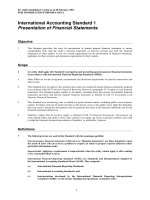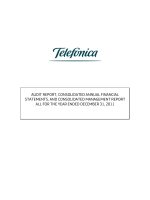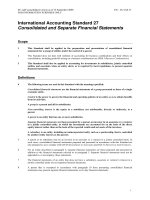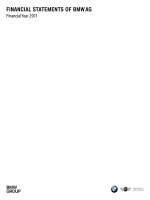engine90 suuberg FINANCIAL STATEMENTS
Bạn đang xem bản rút gọn của tài liệu. Xem và tải ngay bản đầy đủ của tài liệu tại đây (1.33 MB, 47 trang )
Financial Statements
Engineering 90
Prof. Eric Suuberg
What is a Financial Statement?
A financial statement is a quantitative way of showing how a
company is doing.
Three different ways of representing the financial state of a
company:
1. Cash Management (can the company meet its
obligations?)
2. Profitability (Is it making money?) - the income statement
3. Assets versus Liabilities (what is the value of the
company? Who owns what?) - the balance sheet
Each one of these questions is answered by our Financial
Statements.
The Big Three
• Cash Flow Statements
– These answer the important managerial question
“do I have enough cash to run my business”
• Income Statements
– This is the financial sheet that tells you if your
company is profitable or not.
• Balance Sheets
– How much debt do I have? How large are my
assets? This sheet tells you the answer to these
questions.
Cash Flow
Statements
• A report of all a firm’s transactions that involve
cash
• The key elements are revenues (money flowing
in) and expenses (money flowing out).
• Cash flow statements compare the sum of the
revenues to the sum of the expenses on a
regular time basis – usually monthly.
“Manning Electronics” (Engineering 9) – Did Ms.
Manning have enough cash to buy that piece of
equipment for her boat business?
What are Revenues?
• Sales
• Interest from firm’s investments (e.g., a company
savings account)
• Royalty and Licensing payments for appropriate use
of firm’s intellectual property
Another source of cash inflow, but not a revenue is
the cash the firm receives from borrowing money.
What are
Expenses?
There are two types of expenses:
FIXED COSTS
and
VARIABLE COSTS
Fixed Costs
•
•
•
•
•
•
•
•
Rent payments
Salaried employees
Capital Investments and (some) maintenance
Utilities (phone, water, electric, etc)
Insurance
Taxes (on property, plant, and equipment)
Advertising (*)
Others things that do not depend on number of units
produced.
Variable Costs
•
•
•
•
•
•
•
•
Materials Cost
Supplies
Production Wages
Outside / Contracted labor
Advertising (*)
Sales Commissions / Distribution Costs
Equipment Maintenance
Other things that depend on the number of units
produced (e.g. royalties paid)
Putting it all together
So, placing the revenues at the “top” and the
expenses below – you get the following three month
cash flow statement for a hypothetical startup:
Jan-00
Feb-00
Mar-00
$0.00
$0.00
$239.27
$239.27
$1,000.00
$167.04
$1,167.04
EXPENDITURES (outflow)
MATERIALS COST AND MFG. LABOR
SALES COMMISSIONS
COST OF GOODS SOLD (COGS)
$0.00
$0.00
$0.00
$0.00
$0.00
$0.00
$50.00
$100.00
$150.00
GROSS MARGIN
$0.00
$239.27
$1,017.04
$3,000.00
$2,000.00
$500.00
$75.00
$2,000.00
$20,000.00
$27,575.00
$3,000.00
$2,000.00
$500.00
$75.00
$2,000.00
$10,000.00
$17,575.00
$3,000.00
$2,000.00
$500.00
$75.00
$2,000.00
$10,000.00
$17,575.00
($27,575.00)
($17,335.73)
($16,557.96)
REVENUES (inflow)
SALES
INTEREST
RECEIPTS
SALARY AND BENEFITS OF CEO
SALARY AND BENEFITS OF ASSISTANT
RENT
TELEPHONE AND OTHER
ADVERTISING
EQUIPMENT
TOTAL FIXED COSTS
MONTHLY CASH FLOW
$0.00
Cash Flow (cont.)
Jan-00
“Receipts” is the sum of all the
firm’s sales and interest it
collected that month
Gross Margin is the Receipts
minus the COGS
Total Fixed Costs is the sum of all the
fixed costs
REVENUES (inflow)
SALES
INTEREST
RECEIPTS
$0.00
$1,000.00
$167.04
$1,167.04
EXPENDITURES (outflow)
MATERIALS COST AND MFG. LABOR
SALES COMMISSIONS
COST OF GOODS SOLD (COGS)
$0.00
$0.00
$0.00
$0.00
$0.00
$0.00
$50.00
$100.00
$150.00
GROSS MARGIN
$0.00
$239.27
$1,017.04
$3,000.00
$2,000.00
$500.00
$75.00
$2,000.00
$20,000.00
$27,575.00
$3,000.00
$2,000.00
$500.00
$75.00
$2,000.00
$10,000.00
$17,575.00
$3,000.00
$2,000.00
$500.00
$75.00
$2,000.00
$10,000.00
$17,575.00
($27,575.00)
($17,335.73)
($16,557.96)
MONTHLY CASH FLOW
Monthly Cash flow is the Gross Margin
minus the Total Fixed Costs
Mar-00
$0.00
$239.27
$239.27
SALARY AND BENEFITS OF CEO
SALARY AND BENEFITS OF ASSISTANT
RENT
TELEPHONE AND OTHER
ADVERTISING
EQUIPMENT
TOTAL FIXED COSTS
$0.00
Feb-00
Simple Example
• If a company has sales of $500/mo, COGS of
$200/mo, pays $50/mo in salary, and has no other
fixed costs, what is that firm’s three month cash flow
statement?
• Answer:
January
February
March
Revenues
(Sales)
$500
$500
$500
COGS
$200
$200
$200
Salary
$50
$50
$50
Monthly
Cash Flow
$250
$250
$250
What’s Missing?
• Cumulative Cash Flow numbers
• Taxes (… and accumulated depreciation)
• Net Earnings
Cumulative Cash Flow Cash Balance
• Just like the average person keeps their checking
account balance – a firm also needs to know their
cumulative cash flow or cash balance.
• It is an easy calculation – simply take the cumulative
cash flow from this month and add it to the previous
month’s cash balance.
• Your very first month’s cumulative cash balance is
your first month’s monthly cash flow added to your
start-up capital (probably an initial loan or first round
financing).
EBI…. what?
THE CHAIN OF EARNINGS
EBIDT (Earnings Before Interest, Depreciation and Tax)
( - accrued depreciation)
EBIT (Earnings Before Interest and Tax)
( - taxes paid once a year)
EBI
( - interest payments on your debt)
TOTAL EARNINGS
EBIDT
Your EBIDT (Earnings Before Interest Depreciation
and Tax) is
Total Revenues – All Costs that are not depreciable
Non-depreciable Costs
EXPENDITURES (outflow)
MATERIALS COST AND MFG. LABOR
SALES COMMISSIONS
COST OF GOODS SOLD (COGS)
GROSS MARGIN
Capital Equip. (Depreciable Costs)
SALARY AND BENEFITS OF CEO
SALARY AND BENEFITS OF ASSISTANT
RENT
TELEPHONE AND OTHER
ADVERTISING
EQUIPMENT
TOTAL FIXED COSTS
EBITD = Revenues – (COGS + Salary + Rent + Phone +
Advertising)
Calculating Depreciation
1. Continue depreciation on items purchased in earlier
years, using previously established methods
2. Sum up all of that fiscal year’s capital expenses
3. Decide which method of Depreciation your firm
wants to use (Straight Line or Accelerated)
4. Determine the useful lifetime for the assets
5. Determine the salvage value
6. Use the formulas to calculate depreciation on new
equipment
7. Add up all depreciation contributions
NOTE: while EBIDT may be a monthly figure – since
taxes and depreciation are only calculated once a
year – EBIT, EBI, and net earnings MUST be YearEnd numbers.
Calculating Taxes
• Take the EBIDT and subtract the depreciation – this
yields Earnings Before Interest and Tax
• Then calculate profit (or earnings) before taxes by
subtracting interest expenses.
• Then multiply the profit before taxes by your effective
tax rate – that will give the corporate income taxes
the firm owes.
Final Cash Flow Statement
Sep-00
REVENUES (inflow)
SALES
INTEREST
RECEIPTS
EXPENDITURES (outflow)
MATERIALS COST AND MFG. LABOR
SALES COMMISSIONS
COST OF GOODS SOLD (COGS)
GROSS MARGIN
SALARY AND BENEFITS OF CEO
SALARY AND BENEFITS OF ASSISTANT
RENT
TELEPHONE AND OTHER
ADVERTISING
EQUIPMENT
TOTAL FIXED COSTS
MONTHLY CASH FLOW
ENDING CASH BALANCE
EBIDT* PROFITS
CUMULATIVE EBIDT* PROFITS
Depreciation Expense for Tax Purposes
EBIT Profits
Taxes
EBI Profits
Oct-00
Nov-00
Dec-00
$22,000.00
$39.14
$22,039.14
$28,000.00
$85.66
$28,085.66
$35,000.00
$153.62
$35,153.62
$46,000.00
$246.65
$46,246.65
$1,100.00
$2,200.00
$3,300.00
$1,400.00
$2,800.00
$4,200.00
$1,750.00
$3,500.00
$5,250.00
$2,300.00
$4,600.00
$6,900.00
$18,739.14
$23,885.66
$29,903.62
$39,346.65
$3,000.00
$2,000.00
$500.00
$75.00
$2,000.00
$0.00
$7,575.00
$3,000.00
$2,000.00
$500.00
$75.00
$2,000.00
$0.00
$7,575.00
$3,000.00
$2,000.00
$500.00
$75.00
$2,000.00
$0.00
$7,575.00
$3,000.00
$2,000.00
$500.00
$75.00
$2,000.00
$0.00
$7,575.00
$11,164.14
$20,557.84
$16,310.66
$36,868.50
$22,328.62
$59,197.12
$31,771.65
$90,968.77
$11,164.14
($14,442.16)
$16,310.66
$1,868.50
$22,328.62
$24,197.12
$31,771.65
$55,968.77
$4,500.00
$51,468.77
$23,160.95
$28,307.82
NET EARNINGS FOR YEAR (PROFIT AFTER TAX)
$21,507.82
Income Statement
• Income Statement compares the profitability of the
firm to prior years
Operating Information
• Total (yearly) revenues
Net Earnings
$ 172,593.77
minus total (yearly)
Expenses
Cost of Goods Sold
$ 25,725.00
Total
Salary/Benefits
$ 60,000.00
expenditures
Advertising
$ 24,000.00
Rent
Other
$
$
6,000.00
900.00
EBIDT Profits
Depreciation
Taxes
$
$
$
55,968.77
4,500.00
23,160.95
AFTER TAX PROFIT
$
28,307.82
$
6,800.00
$
21,507.82
Accumulated Interest Expenses
Earnings After Accumulated Interest
Cash Flow versus Income
Statements
• Note that the final Net Earnings number for both the
final month of the cash flow statement is exactly the
same as the year-end Net Earnings total for the
Income Statement, reflecting the same time period
REVENUES (inflow)
SALES
INTEREST
RECEIPTS
EXPENDITURES (outflow)
MATERIALS COST AND MFG. LABOR
SALES COMMISSIONS
COST OF GOODS SOLD (COGS)
GROSS MARGIN
SALARY AND BENEFITS OF CEO
SALARY AND BENEFITS OF ASSISTANT
RENT
TELEPHONE AND OTHER
ADVERTISING
EQUIPMENT
TOTAL FIXED COSTS
MONTHLY CASH FLOW
ENDING CASH BALANCE
EBIDT* PROFITS
CUMULATIVE EBIDT* PROFITS
Depreciation Expense for Tax Purposes
EBIT Profits
Taxes
EBI Profits
Sep-00
Oct-00
Nov-00
Dec-00
$22,000.00
$39.14
$22,039.14
$28,000.00
$85.66
$28,085.66
$35,000.00
$153.62
$35,153.62
$46,000.00
$246.65
$46,246.65
$1,100.00
$2,200.00
$3,300.00
$1,400.00
$2,800.00
$4,200.00
$1,750.00
$3,500.00
$5,250.00
$2,300.00
$4,600.00
$6,900.00
$18,739.14
$23,885.66
$29,903.62
$39,346.65
$3,000.00
$2,000.00
$500.00
$75.00
$2,000.00
$0.00
$7,575.00
$3,000.00
$2,000.00
$500.00
$75.00
$2,000.00
$0.00
$7,575.00
$3,000.00
$2,000.00
$500.00
$75.00
$2,000.00
$0.00
$7,575.00
$3,000.00
$2,000.00
$500.00
$75.00
$2,000.00
$0.00
$7,575.00
$11,164.14
$20,557.84
$16,310.66
$36,868.50
$22,328.62
$59,197.12
$31,771.65
$90,968.77
$11,164.14
($14,442.16)
$16,310.66
$1,868.50
$22,328.62
$24,197.12
$31,771.65
$55,968.77
$4,500.00
$51,468.77
$23,160.95
$28,307.82
Operating Information
Net Earnings
$ 172,593.77
Expenses
NET EARNINGS FOR YEAR (PROFIT AFTER TAX)
$21,507.82
Cost of Goods Sold
Total Salary/Benefits
Advertising
Rent
Other
$
$
$
$
$
25,725.00
60,000.00
24,000.00
6,000.00
900.00
EBIDT Profits
Depreciation
Taxes
$
$
$
55,968.77
4,500.00
23,160.95
AFTER TAX PROFIT
$
28,307.82
$
6,800.00
$
21,507.82
Accumulated Interest Expenses
Earnings After Accumulated Interest
Comparison (cont.)
• Further the Income Statement’s year-end figures for
COGS, Salary, Rent, Advertising, and sales should
be the 12 month totals of the cash-flows
corresponding to the respective line item
• Likewise, depreciation and taxes should be equal for
that fiscal year
Balance Sheets
• Unlike Cash-Flow and Income Statements, Balance
Sheets lists ASSETS and LIABILITIES
• Examples of Assets include:
– Land and Capital Equipment less accrued depreciation
– Intellectual Property (if purchased)
– Cash on Hand (which is equal to the year end Cumulative
Cash Balance)
– Accounts Receivable
– Inventory
– Retained Earnings from Previous Years
Balance Sheets (cont.)
• Examples of Liabilities include:
–
–
–
–
–
Short Term Debt (loans)
Long Term Debt (bond issues, etc)
Accounts Payable
Interest Payable
Taxes Payable
• The difference between Assets and Liabilities is your
EQUITY
Example of a Balance Sheet
ASSETS
Current Assets
Cash on Hand
Accounts Receivable
Inventory
Prepaid Expenses
Total Current Assets
FYE 2001
$
$
$
$
$
Property / Plant / Equipment
less depreciation
$
TOTAL ASSETS
$
Current Liabilities
Interest Payable
Short-term loans
Accounts Payable
Income Taxes Payable
Total Current Liabilities
90,968.77
90,968.77
$
$
$
$
$
85,000.00
85,000.00
$50,000.00
$4,500.00
Other Assets
LIABILITIES
FYE 2000
-
$
$
136,468.77 $
FYE 2001
$
$
$
$0.00
6,800.00
$23,160.95
29,960.95
85,000.00
FYE 2000
$
$
$
$
-
Long Term Debt
$
85,000.00 $
85,000.00
TOTAL LIABILITIES
$
114,960.95 $
85,000.00
TOTAL EQUITY
$
21,507.82 $
LIABILITES PLUS EQUITY
$
136,468.77
-
Some Basics of Accounting
• The orderly reporting of the financial activities of a
business
• Most commonly visible forms
• Balance Sheets
• Income Statements
• Used by management, investors,
creditors, government to monitor
business activity









